

The attack on the Reichstag, by Peter Dennis © Osprey Publishing Ltd. Taken from Campaign 159: Berlin 1945.
This list is based upon the troops and equipment available to the German army during the final year of the war in Europe. By this time the Germans have access to some of the very best tanks, tank destroyers and anti-tank guns of the entire war, as well as stalwart weaponry such as the Panzer IV and the fearsome MG42 machine gun. By now the hand-thrown anti-tank grenade has largely passed out of use except amongst some improvised units and Luftwaffe field units, and replaced by the dreaded panzerfaust. Although many infantry still carry bolt-action rifles, many now have the StG44 assault rifle.

In the German army every man is trained with some of the skills of his superiors, and encouraged to show initiative and decisiveness rather than just sit and wait to receive orders.
If an infantry squad’s NCO is killed then roll a D6. On the score of a 1, 2 or 3 the NCO is removed as normal. On the roll of a 4, 5 or 6 one of the other troopers takes over the squad and leads it just as effectively as before. To represent this leave the NCO is place and remove any other model instead. If the NCO is successfully replaced the unit does not suffer the usual –1 Morale penalty for losing its NCO.
German-made machine guns, but in particular the lethal MG42, are vastly superior to their enemies’ and rightly feared by Allied infantrymen.
German infantry units equipped with light and medium machine guns fire one extra shot (4 for a LMG and 5 for a MMG). Note that this only applies to infantry units, and not to vehicles or vehicle crews that carry machine guns.
The list is divided into categories as follows.
| 1 Infantry | Headquarters units |
| Infantry squads and teams | |
| 2 Artillery | Field artillery |
| Anti-tank guns | |
| 3 Vehicles | Tanks |
| Tank destroyers | |
| Self-propelled artillery | |
| Anti-aircraft vehicles | |
| Armoured cars | |
| Transports and tows |
Each platoon is centred upon a core that includes a headquarters unit in the form of a First or Second Lieutenant. Other HQ units can be added to the force, including higher-ranking officers, as well as medical units and supporting observers.
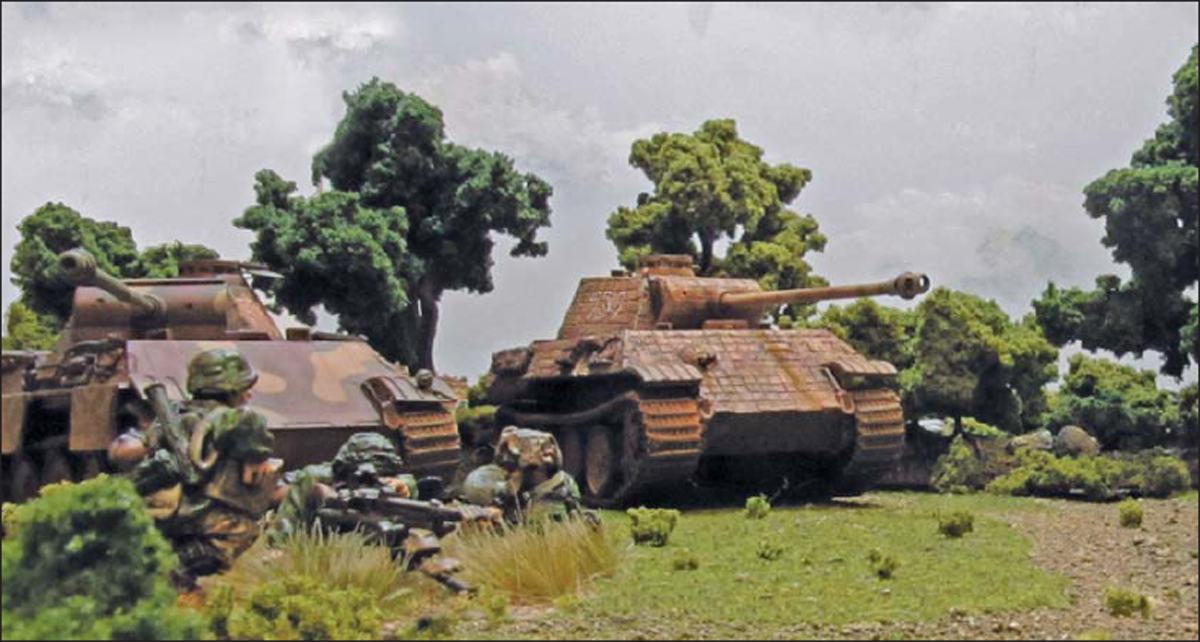
German big cats looking for trouble
German officers were capable and often experienced leaders. In the German army junior officers were trained to undertake the role of their own immediate superiors, enabling them to use their intuitition to take control of situations when necessary. An officer unit consists of the man himself and can include up to two other men acting as his immediate attendants. Because of the high quality of the majority of German officers we rate them as regular or veteran.
| Cost: | Second Lieutenant (Leutnant) |
| 50pts (Regular), 65pts (Veteran) | |
First Lieutenant (Oberleutnant) |
|
| 75pts (Regular), 90pts (Veteran) | |
Captain (Hauptmann) |
|
| 110pts (Regular), 125pts (Veteran) | |
Major (Major) |
|
| 150pts (Regular), 165pts (Veteran) | |
| Team: | 1 officer and up to 2 further men |
| Weapons: | Pistol, submachine gun, rifle, or assault rifle as depicted on the models |
Options:
• The officer may be accompanied by up to 2 men at a cost of +10pts per man (regular) or +13pts per man (veteran)

The Green Devils! German paratroopers advance.
The field medic presents the wounded soldier with his best chance of surviving serious injury and can ensure that lightly wounded soldiers are returned to fighting fitness as rapidly as possible. Junior medical staff such as stretcher-bearers can accompany medics in the field. All medical staff are considered courageous as befits their calling, and hence they are rated as veteran. Under the Geneva Convention medics were unarmed non-combatants – however, such niceties were seldom observed on the Eastern Front at least.
| Cost: | Medic 30pts (Veteran) |
| Team: | 1 medic and up to 2 further men |
| Weapons: | Pistol or none as depicted on the model |
Options:
• The medic may be accompanied by up to 2 men at a cost of +13pts per man
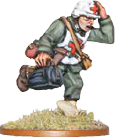
Forward observers are liaison officers responsible for coordinating the attack of heavy artillery batteries from behind the lines or aircraft strikes. They are likely to be accompanied by a radio operator and other immediate attendants. We rate these officers as regular or veteran, those of lesser ability being unlikely to find themselves in such a position.
| Cost: | Artillery Forward Observer |
| 100pts (regular), 115pts (veteran) | |
Air Force Forward Observer |
|
| 75pts (Regular), 90pts (Veteran) | |
| Team: | 1 Forward Observer and up to 2 further men |
| Weapons: | Pistol, submachine gun, rifle, or assault rifle as depicted on the models |
Options:
• The observer may be accompanied by up to 2 men at a cost of +10pts per man (Regular) or +13pts per man (Veteran)
German infantry were generally well trained, well led and well equipped – constituting what was undoubtedly the most effective fighting force in Europe man-for-man. The German army was also heavily outnumbered and as the war progressed compromises in recruitment, equipment shortages, and failures of leadership at the highest level all began to take their toll.
Wehrmacht – meaning armed might – encompasses the forces of the German army, navy and airforce and we will consider them as a whole together with the fourth branch, the Waffen-SS. Some German Luftwaffe formations were effectively ground troops, such as Luftwaffe field divisions and the Hermann Goring Panzer Division. Both paratroops and anti-aircraft units were part of the Luftwaffe. German infantry were provided with the best light machine gun of the war – the rapid firing MG42 – and many squads carried two. By the late war most German infantry squads could carry a proportion of StG44 assault rifles or submachine guns instead of rifles. Most carried panzerfaust, although some Luftwaffe field units carried hand-thrown mines until the end of the war. However, the exact weaponry carried could vary greatly in practice, and so we allow a squad to be built up as follows.
| Cost: | Regular Infantry 50pts |
| Composition: | 1 NCO and 4 men |
| Weapons: | Rifles |
Options:
• Add up to 5 additional men with rifles at +10pts each.
• The NCO and up to 1 man can have a submachine gun instead of rifles for +3pts each
• The NCO and up to 2 men can have assault rifles instead of rifles for +5pts each
• Up to 2 men can have a light machine gun for +20pts – for each light machine gun included another man becomes the loader
• Up to 4 men can have a panzerfaust in addition to other weapons for +5pts each
• If panzerfaust are not taken the squad can be given anti-tank grenades instead for +2pts per man
Special Rules:
• Tank hunters (if anti-tank grenades taken)
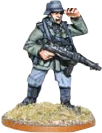
The Waffen-SS formed an elite fighting formation separate from the German army and not strictly part of the Wehrmacht. By the end of the war the Waffen-SS comprised almost 600,000 men. Often fighting at the forefront of an offensive, they proved themselves dangerous adversaries. Fallschirmjägers – German for paratroopers – were elite troops who formed part of the Luftwaffe. Although they took part in airborne operations in the early part of the war, from mid-1944 they were reduced to the role of ground troops. As an elite formation they had access to the best equipment and made considerable use of assault rifles in the form of the FG42 automatic rifle and later the StG44. The German army was not without its experienced troops, the survivors of bloodthirsty fighting on the Eastern Front or the veterans of Africa and Italy. These formations can be built up as follows.
| Cost: | Veteran Infantry 65pts |
| Composition: | 1 NCO and 4 men |
| Weapons: | Rifles |
Options:
• Add up to 5 additional men with rifles at +13pts each
• The NCO and up to 6 men can have a submachine gun instead of rifles for +3pts each
• The NCO and up to 9 men can have assault rifles instead of rifles for +5pts each
• Up to 2 men can have a light machine gun for +20pts – for each light machine gun included another man becomes the loader
• Up to 4 men can have a panzerfaust in addition to other weapons for +5pts each
Even the German army could include green or unmotivated elements – although this would have been rare before the final months of the war. Osttruppen were units recruited from the occupied territories of the east, often from amongst people who had no great love of Stalin’s Russia and often welcomed the German occupation. This included ethnic groups such as Turkmen, Kalmyks, Armenians, Azerbaijanis and Georgians from the east as well as Balts, Finns, Ukrainians, White Russians, and Siberians. These units were generally kept away from the fighting until the final years of the war, when they often surrendered en masse rather than face Allied troops. If the Osttruppen were unwilling the Volkssturm were a different kettle of fish; militia recruited from amongst the old, unfit and young, many being drawn from the ranks of the Hitler Youth. They were ill-equipped with a variety of weaponry including crudely made Volkssturm MP3008 submachine guns and Volkssturmgewehr rifle. Others carried weapons captured earlier in the war or dating back to the previous century. Any of these squads can be built as follows.
| Cost: | Inexperienced Infantry 35pts |
| Composition: | 1 NCO and 4 men |
| Weapons: | Rifles |
Options:
• Add up to 5 additional men with rifles at +7pts each
• The NCO and up to 2 men may have a submachine gun for +3pts
• Up to 4 men can have a panzerfaust in addition to other weapons for +5pts each
• Unless Volkssturm, up to 1 man can have a light machine gun for +20pts – for each light machine gun included another man becomes the loader. Volkssturm units cannot have light machine guns
• Volkssturm units can be Green at no extra points cost
• Osttruppen units can be Shirkers for a reduction of 3pts per man
• Unless Osttruppen are equipped with panzerfaust, units can be given anti-tank grenades for +2pts per man
Special Rules:
• Volkssturm units can be Green
• Osttruppen can be Shirkers
• Tank hunters (if anti-tank grenades taken)
TOP SECRET
In the fighting around Hastenrath during the assault upon the Siegfried Line, one brave tanker defied the odds when the rest of his crew were killed. With his Sherman immobilised at night in the middle of a road junction, he might have sensibly decided to abandon the tank and make a run for it. Instead he continued to load and fire the Sherman’s main armament against advancing German infantry. Once he had run out of HE shells the lone crewman resorted to using the tank’s .30 calibre machine guns. When the ammunition for these was gone he opened the turret hatch and manned the .50 calibre machine gun. Having exhausted all the .50 calibre ammo, he then resorted to the .45 Thomson carried in the fighting compartment, proceeding to empty this and his pistol towards the enemy before climbing back inside the tank once more. The Germans pressed forward and clambered onto the tank. Its occupant cracked open the hatch just sufficiently to toss a grenade onto the deck where it exploded killing the luckless foes. The lone tanker continued in this fashion until all of his grenades were gone. American infantry found him the following morning, alive and well, with his tank surrounded by the bodies of dead and wounded Germans.
As the Germans found it increasingly difficult to field enough men or equipment, it was decided to create new kinds of formation with more emphasis on light automatic weapons – in particular the new StG44 assault rifle – partly to compensate for lack of training and inexperience amongst recruits. Volks Grenadiers should not be confused with Volkssturm, a desperate militia of old men and young boys. In theory at least the Volk Grenadiers were formed around a core of veteran troops and NCOs and were often highly motivated and patriotic fighters. Units were often under-strength and supply problems meant they carried an assortment of weapons – although we have chosen to present them as ideally intended – armed to the teeth with assault rifles. Whilst many Volks Grenadier units crumbled before the enemy, others fought with astonishing tenacity, and to reflect this we make them green but with a further chance of emerging as regulars or even veterans under fire.
| Cost: | Inexperienced Infantry 60pts |
| Composition: | 1 NCO and 4 men |
| Weapons: | Assault rifles |
Options:
• Add up to 5 additional men with rifles at 7pts each
• Any riflemen can be given an assault rifle instead at +5pts each
• Any riflemen can be given a submachine gun instead at +3pts per model
• Up to 1 man can have a light machine gun for +20pts – for each light machine gun included another man becomes the loader
• Up to 4 men can have a panzerfaust in addition to other weapons for +5pts each
Special Rules:
• Green – Volks Grenadier squads are green and must test when they first suffer a casualty as described on p42. However, if Volks Grenadiers pass their test and are uprated to regular infantry, then roll a further die and on a roll of a 5 or 6 they are uprated again to veterans
The Germans were equipped with two excellent machine guns in the MG34 and rapid firing MG42 – known to Allied troops as ‘Hitler’s Buzzsaw’ because of its distinctive noise. Unlike other armies the Germans used the same machine gun both as a squad weapon and as a tripod mounted support weapon. The tripod mount provided a much more stable firing platform and made it easier to keep up a continuous fire using a belt feed. We therefore treat the tripod-mounted gun as a medium machine gun, whilst the squad weapon is treated as a light machine gun. As described in the rules for team weapons, although crew members would be likely to carry rifles or submachine guns we consider them to be preoccupied serving their weapon and so do not include separate arms.
| Cost: | 35pts (Inexperienced), 50pts (Regular), 65pts (Veteran) |
| Team: | 3 men |
| Weapon: | 1 MMG |
Special Rules:
• Team weapon
• Fixed
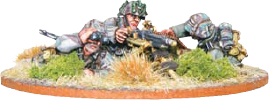
The panzerschreck was a German development of the bazooka, firing a large calibre shaped-charge rocket projectile. The back-blast from the weapon was so intense early teams wore protective capes and masks. Later a blast shield was fitted to the weapon giving it its distinctive appearance. The panzerschreck and disposable anti-tank panzerfaust had replaced the anti-tank rifle Panzerbuchse 39 by 1944.
| Cost: | 56pts (Inexperienced), 80pts (Regular), 104pts (Veteran) |
| Team: | 2 men |
| Weapons: | 1 panzerschreck |
Special Rules:
• Team weapon
• Shaped charge
The value of the sniper was brought home during the battle of Stalingrad where Russian snipers took such a heavy toll of German troops. The Wehrmacht trained and equipped marksmen to undertake a specialist role as snipers. A variety of rifles were used for sniping, including the standard infantry rifle and semi-automatic Gewehr 43. All were fitted with telescopic sights and snipers were provided with specially manufactured ammunition.
| Cost: | 50pts (Regular), 65pts (Veteran) |
| Team: | 2 men |
| Weapons: | 1 rifle |
Special Rules:
• Team weapon
• Sniper
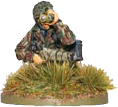
Flamethrowers – flammenwerfer – were used throughout the war and were often employed against buildings or fortifications. These were not weapons to put into the hands of the inexperienced, so we rate flamethrower teams as regular or better. At the very end of the war the Germans were developing a lighter, smaller design that carried enough fuel for a single burst – effectively a one shot flamethrower – the Einstossflammenwerfer. As with many of the more unusual weapons under development at the end of the war, hostilities ceased before this could be issued.
| Cost: | 50pts (Regular), 65pts (Veteran) |
| Team: | 2 men |
| Weapons: | 1 infantry flamethrower |
Special Rules:
• Flamethrower
• Team weapon (Flammenwerfer)
The Germans had mortars – granatwerfer – in several calibres, the lightest of which was the 50mm infantry mortar. This was basically a close-range support weapon that could easily be carried and used by infantry. The Germans also made use of captured mortars including the Russian 50mm. As the war progressed the 50mm mortar was replaced with a lightened version of the 80mm mortar in the same role – this was the “Stummelwerfer” or “Stump-Thrower”. By the period represented by this list the 50mm had been dropped from frontline service, although it could still be found in the hands of garrison troops and reservists. Either way, we treat both the 50mm and shortened 80mm as light mortars.
| Cost: | 24pts (Inexperienced), 35pts (Regular), 46pts (Veteran) |
| Team: | 2 men |
| Weapon: | 1 light mortar |
Special Rules:
• Team weapon
• Indirect fire
• HE (D3)
The standard German medium mortar of the war was the 80mm Granatwerfer 34. It was a very effective and accurate weapon that could provide long-range fire support.
| Cost: | 35pts (Inexperienced), 50pts (Regular), 65pts (Veteran) |
| Team: | 3 men |
| Weapon: | 1 medium mortar |
Options:
• May add Spotter for +10pts
Special Rules:
• Team weapon
• Fixed
• Indirect fire
• HE (D6)
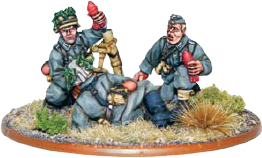
TOP SECRET
Michael Wittmann was one of Germany’s most famous ‘panzer aces’ of World War II. During his career he was credited with destroying 138 enemy tanks and 132 anti-tank guns. He fought throughout the war until his death. During the battle of France and invasion of Greece he commanded a Stug III assault gun (Sturmgeschutz III). But it was on the Eastern Front where Wittmann was to establish his reputation and score most of his kills. He quickly rose to the rank of second lieutenant (Untersturmfuhrer) and by the time of the battle of Kursk he was leading a platoon of Tiger tanks. In April of 1944 his company was transferred to SS-Heavy Panzer Battalion 101 in Normandy. During the fighting Wittmann was ordered to occupy the small town of Villars-Bocage. Unknown to his commanders the town had already been occupied by the British 22nd Armoured Brigade. Observing elements of the enemy formation advancing along the road out of the town, Wittmann saw his opportunity and struck. Within a quarter of an hour his five Tiger tanks had destroyed more than a dozen enemy tanks and at least as many other vehicles. His advance against the town had been courageous, but ill prepared and arguably reckless. In August 1944, as he led a formation in a counter-attack towards Saint-Aignan-de-Cramesnil, his Tiger was caught in crossfire from Sherman Fireflies belonging to the Northamptonshire Yeomanry and the Sherbrooke Fusiliers. A single shot penetrated his tank’s engine compartment causing an ammunition explosion that blew the Tiger apart, throwing the turret some distance from the wreck. Wittmann and his crew were killed instantly.
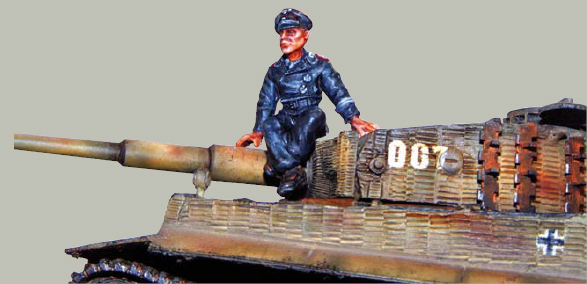
The heavy mortar used by the German was the 120mm calibre Granatwerfer 42. It was a close copy of captured Russian mortars and was developed to give the infantry an even longer range and heavier weight of shot than the 80mm mortar.
| Cost: | 46pts (Inexperienced), 65pts (Regular), 84pts (Veteran) |
| Team: | 4 men |
| Weapon: | 1 heavy mortar |
Options:
• May add Spotter for +10pts
Special Rules:
• Team weapon
• Fixed
• Indirect fire
• HE (2D6)
German field artillery often lagged behind that of Germany’s enemies in terms of development and effectiveness. Many of the larger weapons dated from the previous war, whilst field guns were frequently those captured during earlier campaigns. Outranged by bigger and heavier Russian weapons, and substantially outgunned on both Eastern and Western Fronts, the Germans soldiered on with what could be mustered.
The Germans employed a tremendous variety of light infantry guns, mountain guns and field guns and howitzers, which generally had a calibre of 75mm. These guns were used for close support and were light enough to be manhandled by their crews. As with all team-based units artillerymen serving their weapon are treated as unarmed – even where individual models might carry small arms.
| Cost: | 40pts (Inexperienced), 50pts (Regular), 60pts (Veteran) |
| Team: | 3 men |
| Weapons: | 1 light howitzer |
Special Rules:
• Gun shield
• Team weapon
• Fixed
• Howitzer
• HE (D6)
The Germans employed howitzers of 105mm calibre and larger at divisional level. These long-ranged weapons would be unlikely to see action in the kind of fire fights portrayed in the Bolt Action game, unless of course they were to be caught up in a rapid enemy advance. In these circumstances artillery pieces would certainly give a good account of themselves.
| Cost: | 60pts (Inexperienced), 75pts (Regular), 90pts (Veteran) |
| Team: | 4 men |
| Weapon: | 1 medium howitzer |
Options:
• May add Spotter for +10pts
Special Rules:
• Gun shield
• Team weapon
• Fixed
• Howitzer
• HE (2D6)
The Germans employed a variety of heavy field guns, mostly of 150mm calibre including the Feldhaubitze 18 or sFH 18 which formed the standard divisional heavy artillery. The same weapon was used in the Hummel self-propelled gun. Of course, these were not the largest guns available to the German armed forces, but they were the most common of the heavy artillery, larger guns often being favoured for coastal defence rather than action in the field.
| Cost: | 92pts (Inexperienced), 115pts (Regular), 138pts (Veteran). |
| Team: | 5 men |
| Weapon: | 1 heavy howitzer |
Options:
• May add Spotter for +10pts
Special Rules:
• Gun shield
• Team weapon
• Fixed
• Howitzer
• HE (3D6)
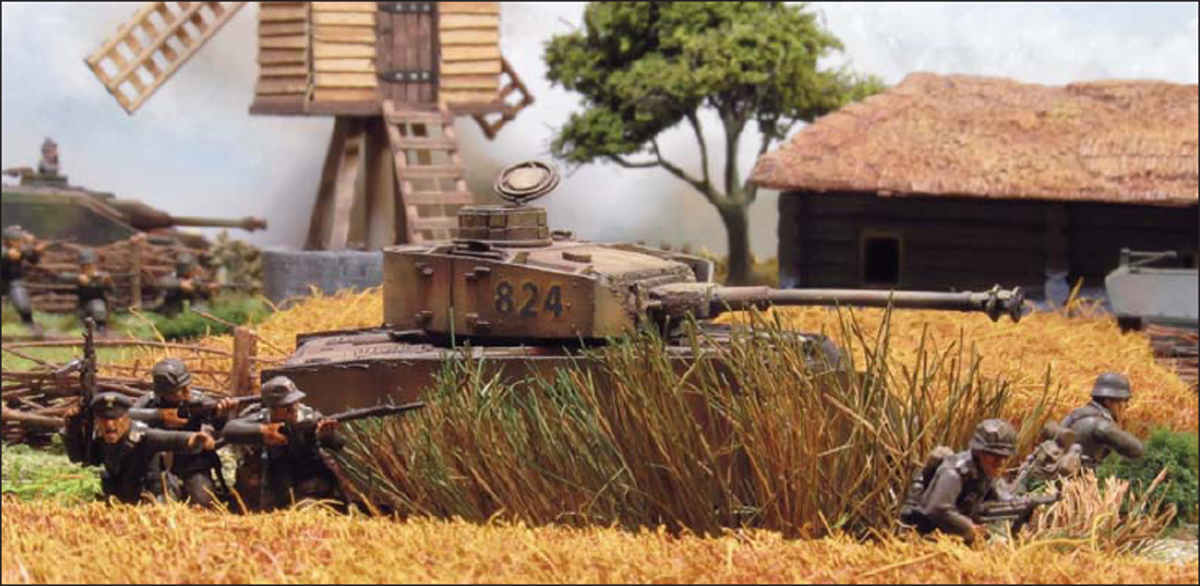
Pz IV moving through a village
During the whole of World War II German anti-tank gun developments remained firmly ahead of that of the Allies, with continuous improvements creating weapons with greater velocities capable of punching through the thickest armour. This gave the Germans a significant advantage in tank warfare even when vastly outnumbered.
Panzerbüchse is German for anti-tank rifle but the sPzB 41 was effectively a small anti-tank gun with its own carriage and crew. This remarkable gun was designed on the ‘squeeze bore’ principle with the bore reducing from 28mm to 20mm, propelling the shell to a much higher velocity than with a conventional anti-tank gun. Combined with tungsten core ammunition this gave the sPsB 41 remarkable armour penetration at short ranges – though performance dropped off rapidly over distance. It was used throughout the war by a variety of troops – even including paratroopers. By the late war it was the only light anti-tank gun in service – the 37mm Pak 36 having been withdrawn as an anti-tank gun, although often fitted as a support weapon to carriers.
| Cost: | 40pts (Inexperienced), 50pts (Regular), 60pts (Veteran) |
| Crew: | 2 men |
| Weapon: | Light anti-tank gun |
Special Rules:
• Team weapon
• Fixed
• Squeeze-bore – at ranges of up to 12” armour penetration is increased by 2 to +6, at over half range armour penetration is reduced by 2 instead of the usual 1 to +2
The Pak 38 was a good weapon in its day with a 50mm calibre and tungsten core ammunition. During the invasion of Russia it was one of the few German tank guns capable of piercing the front armour of a T34. The 50mm gun was gradually replaced by the more powerful 75mm Pak 40 as the heavier gun became available in increasing numbers through 1942 and 43. Some remained in service until the end and were still effective against the majority of Allied tanks.
| Cost: | 60pts (Inexperienced), 75pts (Regular), 90pts (Veteran) |
| Crew: | 3 men |
| Weapon: | Medium anti-tank gun. |
Special Rules:
• Gun shield
• Team weapon
• Fixed
The Pak 40 was the standard German anti-tank gun of the late war period. It was an effective weapon that was capable of destroying almost any Allied tank. It was, however, a great deal heavier than the Pak 38 and could only be practically towed by artillery tractors.
| Cost: | 88pts (Inexperienced), 110pts (Regular), 132pts (Veteran) |
| Crew: | 4 men |
| Weapon: | Heavy anti-tank gun |
Special Rules:
• Gun shield
• Team weapon
• Fixed
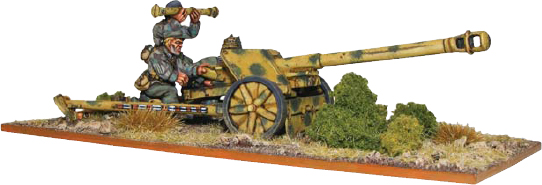
German Army 7.5cm Pak 40 anti-tank gun
The Pak 43 was the most formidable German anti-tank gun used in significant numbers during the war and one of the most dreaded weapons to be found on the battlefield. This was a version of the same high-velocity 88mm gun that equipped the Tiger II, and it was easily capable of penetrating and destroying even the most heavily armoured Allied tanks including such monsters as the Soviet IS-II. It was a very heavy weapon and early versions were fixed to a stable cruciform mount much like the Flak version of the weapon. However, by the late war this had been augmented by a split-trail wheeled carriage – a version known as the ‘barn door’ from the appearance of the gun’s large, flat gun shield.
| Cost: | 112pts (Inexperienced), 140pts (Regular), 168pts (Veteran) |
| Crew: | 5 men |
| Weapon: | Super-heavy anti-tank gun |
Special Rules:
• Gun shield
• Team weapon
• Fixed
By the late war the Germans had developed a bewildering variety of tanks and tank destroyers including some of the heaviest tanks to see action during the whole conflict. The Panzer IV, up-gunned and up armoured since the beginning of hostilities, is still a formidable weapon, whilst the Tiger II and Panther can meet and defeat any tank the Allies can pitch against it.
The Luchs – Lynx – was the last version of the Panzer II, the light tank with which the German had commenced hostilities. By the final year of World War II the role of the light tank had been reduced to that of a reconnaissance vehicle. As such it was a very effective weapon that was easily capable of matching Allied armoured cars. The Luchs was armed with a 20mm autocannon and co-axial machine gun – plans to up-gun with a 50mm cannon were brought to a halt with the end of the war.
| Cost: | 92pts (Inexperienced), 115pts (Regular), 138pts (Veteran) |
| Weapons: | One turret-mounted light autocannon with co-axial MMG |
| Damage Value: | 8+ (light tank) |
Special Rules:
• Recce
The Panzer IV saw service throughout the war from the Polish campaign and the battle of France through to D-Day and the fall of Germany. Its defensive armour of 50mm was adequate – although vulnerable to the more powerful Allied anti-tank guns developed in the last years of the war. Its main armament was capable of penetrating most Allied tanks at long range. The details included here cover the Aust F2, G, H and J versions of this ubiquitous German tank – all armed with the 75mm Kampfwagenkanone 40 (KwK 40).
| Cost: | 188pts (Inexperienced), 235pts (Regular), 282pts (Veteran) |
| Weapons: | One turret-mounted heavy anti-tank gun with co-axial MMG and one forward facing hull-mounted MMG |
| Damage Value: | 9+ (medium tank) |
The Panther was the best all-round German tank of the war and although conceived as a medium tank, at 45 tons and with frontal armour over 100 thick we shall rate the front armour more highly. The Panther’s thick, sloping front armour was copied from the Russian T-34 but the main gun was a weapon that far excelled anything the Russians possessed, the high velocity KwK 42 L70, which was capable of penetrating any Allied tank in service when it was first introduced.
| Cost: | 355pts (Regular), 426pts (Veteran) |
| Weapons: | One turret-mounted super-heavy anti-tank gun with co-axial MMG and forward facing hull-mounted MMG |
| Damage Value: | 9+ (medium tank) |
Special Rules:
• The Panther’s heavy frontal armour has a rating of +1 giving it the 3 same frontal value as a heavy tank (10+)
The Tiger is probably the best known of all German tanks of World War II and certainly the tank most feared by the Allies! It was a lumbering monster of a tank and its 88mm gun was easily capable of destroying even the most heavily armoured Allied tanks of the day. By the end of the war the Tiger had been superseded by better designs, but it still valiantly fought on, and Tigers would stalk the ruins of Berlin in the last days of the Third Reich.
| Cost: | 395pts (Regular), 474pts (Veteran) |
| Weapons: | One turret-mounted super-heavy anti-tank gun with co-axial MMG and forward facing hull-mounted MMG |
| Damage Value: | 10+ (heavy tank) |
The Tiger II has been described as the most powerful combat tank of the war with armour that was almost impervious to the guns of Allied tanks and a high velocity 88mm gun that could destroy any Allied tank with relative ease. Wherever they were used they dominated the battlefield, but there were never enough to stem the advancing Allied armies and in the end the Germans were simply overwhelmed by numbers.
| Cost: | 555pts (Regular), 666pts (Veteran) |
| Weapons: | One turret-mounted super-heavy anti-tank gun with co-axial MMG and forward facing hull-mounted MMG |
| Damage Value: | 11+ (super-heavy tank) |
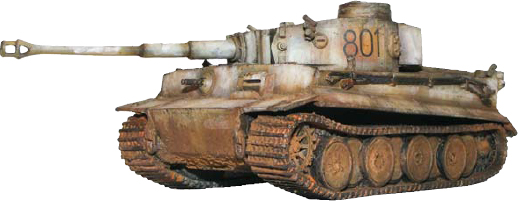
German Tiger I ausf H in winter camouflage
As the war progressed the Germans came to believe that turretless tank destroyers could be at least as effective as tanks in many situations, and – of course – they were much quicker and cheaper to build than tanks with their complex turret mechanics. In fact, although excellent in an ambush role, when pitched against enemy tanks in the open, tank destroyers were at a huge disadvantage, being unable to turn their weapon to bear beyond their immediate front. Even so, the Jagdtiger was the heaviest and most heavily armed armoured fighting vehicle of the war, the most potent weapon of its kind by far.
The Sturmgeschutz – assault gun – was developed as an infantry support weapon based on the Panzer III chassis. By the later part of the war it was armed with the same long barrelled 75mm anti-tank gun as the Panzer IV and often deployed as a tank destroyer. The Stug III was produced in more numbers than any other German armoured fighting vehicle – over 10,000 in all. Later Stugs incorporated a co-axial machine gun and many vehicles that lacked them were subsequently retrofitted to provide more firepower against enemy infantry. Production of the Stug III was severely curtailed by Allied bombing, following which the Germans shifted some Panzer IV production over to assault guns built on the Panzer IV chassis. These Stug IVs were entirely comparable to the earlier Stugs in performance and mounted the same gun, so the two types have been included together.
| Cost: | 184pts (Inexperienced), 230pts (Regular), 276pts (Veteran) |
| Weapons: | One casement-mounted forward facing heavy anti-tank gun and remotely operated MMG with 360-degree arc of fire |
| Damage Value: | 9+ (medium tank) |
Options:
• May add a forward facing co-axial MMG for +15pts
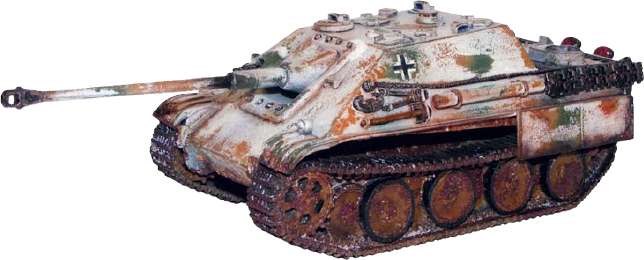
Jagdpanther tank destroyer
The Jagdpanzer IV was developed in 1943 as a tank destroyer based on the Panzer IV chassis. Its frontal armour was thicker than a Panzer IV, and with its low profile and powerful gun it proved a successful weapon that continued to serve the German forces until the war’s end. Initial versions of the Jagdpanzer IV were produced with the same 75mm gun as the Panzer IV, but later versions were fitted with the more powerful 75mm gun from the Panther.
| Cost: | 216pts (Inexperienced), 270pts (Regular), 324pts (Veteran) |
| Weapons: | One casement-mounted forward facing heavy anti-tank gun and forward facing hull-mounted MMG |
| Damage Value: | 9+ (medium tank) |
Options:
• May replace heavy anti-tank gun with super-heavy anti-tank gun (75mm L70) for 80pts
Special Rules:
• The Jagdpanzer’s heavy frontal armour has a rating of + 1 giving it the 3 same frontal value as a heavy tank (10+)
TOP SECRET
Before the war the armed services of various nations had developed their own tank designs. At the time no one was really sure what the role of tanks might be in any future conflict. Some tacticians clung to the idea of the tank as a mobile pillbox advancing slowly in support of infantry. Others considered that tanks would have no significant part to play at all, arguing that the penetrating power of the modern anti-tank gun rendered tanks obsolete. A few theorists – such as Captain Liddell Hart – foresaw the potential of mobile armoured formations combining infantry and tanks.
When the war began both sides were obliged to make the best use of the weapons and doctrines at their disposal. The tanks available to the Germans were not necessarily superior to those of their enemies; however, German tanks were mechanically reliable, they were equipped with radios, and their crews were likely to be more experienced. More importantly, German generals were willing to exploit the speed of the tank as part of an unstoppable Blitzkrieg. In comparison British tanks were slow, mechanically unreliable and many were equipped only with machine guns. French tanks – though some of the most advanced of the day – lacked radios, and the prevailing defensive tactical doctrine made it impossible to exploit their mobility and firepower.
So – as wargamers can we do better? Is it possible to set a wargame during the Polish campaign, the battle of France, the Norwegian campaign or the early East Africa or Western Desert campaigns? Of course the answer is yes indeed, for such a game can be every bit as challenging as games set during the latter part of the war. With the benefit of hindsight we can allow ourselves the luxury of deploying our formations in a manner that exploits the strength of the various arms unhindered by outmoded tactical ideas, supply problems, or mechanical failings (all our tanks are excellently maintained by imaginary engineers of unparalleled efficiency). We will also wish to fight games that are reasonably fair – pitching forces against each other that are more or less equal in size and potency. Within the context of our wargame even the lightest tanks of the early war become terrifying monsters of steel. The best of the Allied designs, such as the French Somua S35, are a good match for the German (and captured Czech) vehicles likely to oppose them. The French Char B and British Matilda are more heavily armoured than any contemporary German tank, even if they are also comparatively slow as a result.
The Jagdpanther tank destroyer was based on the Panther chassis and combined that tank’s excellent mobility with a hardhitting KwK 43 88mm gun as used in the Tiger II. This powerful gun was mounted into an extended front glacis that created a heavily-armoured casement for the crew. Jagdpanthers took part in the fighting on both Eastern and Western Fronts and were used during the battle of the Bulge. However, like all German tank destroyers its arc of fire was limited, reducing its effectiveness when deployed in a mobile role.
| Cost: | 312pts (Inexperienced), 390pts (Regular), 468pts (Veteran) |
| Weapons: | One hull mounted forward facing super-heavy anti-tank gun and one forward facing hull-mounted MMG |
| Damage Value: | 10+ (heavy tank) |
The Jagdtiger – Hunting Tiger – was the heaviest and most powerfully armed of all German tank destroyers of World War II. It was based upon the Tiger II tank, but the turret was replaced by a fixed casement with armour up to 250mm thick and mounting a 128mm Pak 44 anti-tank gun (Pak is short for Panzerabwehrkanone – anti-tank gun and 44 indicates the year the weapon was designed). Although of considerable weight the 128mm weapon was not substantially better than the 88mm gun of the Tiger II at short rnages, but it was superior at long range and could knock out Allied tanks well beyond their own effective range.
| Cost: | 440pts (Inexperienced), 550pts (Regular), 660pts (Veteran) |
| Weapons: | One casement-mounted forward facing super-heavy anti-tank gun and one forward facing hull-mounted MMG |
| Damage Value: | 11+ (super-heavy tank) |
Special Rules:
• The 128mm Pak 44 was almost as effective at long ranges as at short range – so it does not suffer the –1 penetration penalty when shooting at targets at over half range. It counts its full +7 penetration bonus at all ranges
The Marder started life as a conversion of various captured and obsolete vehicles to produce mobile anti-tank support for infantry. Early Marders were often armed with captured Russian guns, but by the late war all used the German 75mm Pak 40 anti-tank gun. The last Aust M version – as described here – featured an open-topped fighting compartment on a Panzer 38t chassis. Because of its weak superstructure and open fighting compartment, we give it a damage value of 7+, as an armoured carrier.
| Cost: | 132pts (Inexperienced), 165pts (Regular), 198pts (Veteran) |
| Weapons: | One forward facing heavy anti-tank gun and one forward facing hull-mounted MMG |
| Damage Value: | 7+ (armoured carrier) |
Special Rules:
• Open-topped
The Nashorn – rhinoceros – was built to mount the powerful 88mm KwK43, the same weapon that would eventually be carried by the Tiger II and Jagdpanther. It was a hasty response to the need for mobile heavy anti-tank guns, with its vulnerable open-topped superstructure and light construction that enables it to bear the weight of its mighty gun. Although soon superseded by better designs, the Nashorn soldiered on until the end of the war equipping heavy anti-tank battalions. The Nashorn had no fixed secondary weapons but the crew-carried an MG34 machine gun, which we allow them to make use of if required.
| Cost: | 212pts (Inexperienced), 265pts (Regular), 318pts (Veteran) |
| Weapons: | One forward facing super-heavy anti-tank gun and one crew-carried MMG with 360-degree arc of fire |
| Damage Value: | 8+ (light tank) |
Special Rules:
• Open-topped
• The crew can either shoot the Nashorn’s main gun or the MMG, but not both
The Ferdinand, Elefant – or Panzerjäger Tiger – was an ad hoc creation that married the new high velocity 88mm KwK43 with the rejected Porche version of the Tiger tank. It was produced at the same time as the lightly armoured Nashorn but, where the Nashorn was constructed as lightly as possible, the Elefant was made even heavier by the addition of a further 100mm of frontal armour, making 200mm in all. With all this extra weight the Elephant was rendered unreliable, unmanoeuvrable and slow. The Elefant’s mechanical components were under such strain that operational reliability was severely compromised, and this is represented in the game by the special rule given below. Production was limited to a single run of under a hundred vehicles, all of which were completed in 1943. Elefant equipped units continued to fight on the Russian front and in Italy until the end of the war.
| Cost: | 408pts (Inexperienced), 510pts (Regular), 612pts (Veteran) |
| Weapons: | One casement-mounted forward facing super-heavy anti-tank gun and one forward facing hull-mounted MMG |
| Damage Value: | 11+ (super-heavy tank) |
Special Rules:
• Slow
• If the Elefant suffers one or more pin markers as a result of an enemy attack it automatically suffers one further pin marker in addition, such is its extreme operational unreliability
TOP SECRET
Sylvester Stadler commanded the Panzer Grenadier Regiment ‘Der Führer’ at the battle of Kursk. He witnessed an unusual clash between 50 Soviet T-34 tanks and 26 German T-34s captured at Karkov. The German T-34s, repainted in German camouflage and conspicuously marked with large black crosses, quickly gained the upper hand over their creators. According to Stadler all 50 enemy tanks were set ablaze. He says, ‘The Soviet tanks each had a barrel of fuel attached to its back. These could be set on fire by a well-aimed shot, and shortly after the whole tank exploded.’
The Hetzer – or Jagdpanzer 38t to give it its proper designation – was a small sized and cheap alternative to the bigger tank destroyers such as the Jagdtigers and Jagdpanther. It carried a relatively powerful 75mm gun – a version of that used on the Stug III. The little vehicle’s frontal armour was as good as that of most Allied tanks although its side armour was relatively weak. As well as the forward facing hull-mounted main armament, the Hetzer had a remotely operated machine gun that could be fired by the crew from within the vehicle.
| Cost: | 188pts (Inexperienced), 225pts (Regular), 262pts (Veteran) |
| Weapons: | One hull-mounted forward facing heavy anti-tank gun and one remotely operated MMG with 360-degree arc of fire |
| Damage Value: | 9+ (medium tank) |
Special Rules:
• The Hetzer’s weak side armour means that all shots to the side of the vehicle count as to the rear with a +2 penetration modifier
German self-propelled artillery tended to be conversions of existing vehicles, often those captured from the enemy or otherwise obsolete. This pragmatic approach produced a hotchpotch of self-propelled artillery that undoubtedly served its purpose of providing mobile fire support.
The Wespe – German for Wasp – was an adaptation of the Panzer II chassis to take a 105mm field gun in an open-topped superstructure. They proved very successful and were allocated to armoured artillery battalions with Panzer divisions alongside the heavier Hummel.
| Cost: | 116pts (Inexperienced), 145pts (Regular), 174pts (Veteran) |
| Weapons: | One forward facing medium howitzer and one crew-carried MMG with 360-degree arc of fire |
| Damage Value: | 8+ (light tank) |
Special Rules:
• Open-topped
• The crew can either shoot the Wespe’s main gun orthe MMG, but not both

German counter-attack on D-Day, by Peter Dennis © Osprey Publishing Ltd. Taken from Command 5: Erwin Rommel.
The Hummel – German for Bumble Bee – carried a 150mm artillery piece on a chassis that combined elements of existing Panzer III and Panzer IV running gear. This same chassis was also used for the Nashorn tank destroyer.
| Cost: | 148pts (Inexperienced), 185pts (Regular), 222pts (Veteran) |
| Weapons: | One forward facing heavy howitzer and one crew-carried MMG with 360-degree arc of fire |
| Damage Value: | 8+ (light tank) |
Special Rules:
• Open-topped
• The crew can either shoot the Hummel’s main gun or the MMG, but not both
From 1943 the Sturmgeschutz was increasingly used in an anti-tank role, and this prompted the development of a new infantry support version – the Sturmhaubitze 42 or StuH 42. The new assault gun was fitted with a shortened 105mm howitzer instead of the 75mm gun fitted to Stugs during the early days of the war.
| Cost: | 152pts (Inexperienced), 190pts (Regular), 228pts (Veteran) |
| Weapons: | One casement-mounted forward facing medium howitzer and remotely operated MMG with 360-degree arc of fire |
| Damage Value: | 9+ (medium tank) |
The SdKfz 4 was an armoured version of the Maultier design – basically a half-track truck with an armoured body. The SdKfz 4/1 Panzerwerfer 42 mounted a 150mm Nebelwerfer multiple rocket launcher whilst the basic SdKfz 4 truck acted as an ammunition carrier. This produced an effective mobile multiple rocket launcher that served with Nebeltruppen on the Eastern and Western Fronts.
| Cost: | 92pts (Inexperienced), 115pts (Regular), 138pts (Veteran) |
| Weapons: | One forward facing Nebelwerfer multiple rocket launcher (heavy mortar) |
| Damage Value: | 7+ (armoured carrier) |
Options:
• The multiple rocket launcher can be replaced with one forward facing pintle-mounted MMG covering the front arc (SdKfz 4 ammunition carrier version). This reduces the point value by 55pts
Special Rules:
• Indirect fire
• HE (2D6)
• Multiple launcher
• Open-topped
• Flak (if MMG ammunition carrier option chosen)
The Germans employed a great many mobile anti-aircraft guns and a large proportion of the German war effort was committed to air defence. Mobile anti-aircraft weapons often made use of existing vehicle chassis as in the case of the examples given here.
As the Germans lost air superiority to the Allies their ground forces become ever more vulnerable to attack from enemy aircraft. The Flakpanzer IV was an attempt to provide the antiaircraft platoons of Panzer Divisions with an answer. There were several versions, with different armaments mounted in different ways. The Mobelwagen (Furniture Van – so called because of its boxy superstructure) had a single 37mm gun on an open-topped platform. The Wirbelwind (Whirlwind) had an open turret with quad-mounted 20mm guns. The Ostwind replaced the 20mm guns with a single 37mm gun and extra machine gun – making it equally useful against enemy troops and light vehicles. The Kugelblitz (Ball lightning) had twin mounted 30mm guns in a closed turret – but the war ended before it could be introduced.
| Cost: | 130pts (Inexperienced), 160pts (Regular), 190pts (Veteran) |
| Weapons: | One platform-mounted heavy autocannon with 360-degree arc of fire and one forward facing hull-mounted MMG |
| Damage Value: | 9+ (medium tank) |
Options:
• May exchange heavy autocannon for 4x light autocannon in open turret for +80pts
• May exchange heavy autocannon for heavy autocannnon and MMG in open turret for +10pts
• May exchange heavy autocannon for twin heavy autocannon (30mm) in closed turret for +45pts
Special Rules:
• Open-topped vehicle – unless the twin 30mm Kugelblitz option is taken in which case the vehicle is fully enclosed
• Flak
The SdKfz 7 was adapted as an anti-aircraft platform to carry 20mm or 37mm anti-aircraft guns. It made a very effective and mobile anti-aircraft defence vehicle.
| Cost: | 48pts (Inexperienced), 60pts (Regular), 72pts (Veteran) |
| Weapons: | One platform-mounted heavy autocannon (37mm Flak 38) with 360-degree arc of fire |
| Damage Value: | 6+ (soft-skin carrier) |
Options:
• May add platform-mounted quadruple light autocannon (4x20mm Kwk 38) with 360-degree arc of fire for +80pts
Special Rules:
• Flak
German armoured cars are immediately recognisable both in the six-wheeled and eight-wheeled configurations. They were primarily designed for reconnaissance duties, but despite this were produced with a variety of weaponry that makes them especially valuable as support for infantry. Some half-tracks were also converted to undertake the same role, and these are also included in this section.
The SdKfz 222 was a light armoured car used for scouting and as a radio car (Panzerfunkwagen). It mounted a 20mm gun alongside an MG34 machine gun. The open turret enabled the main gun to be used in an anti-aircraft role. Armoured cars formed part of the reconnaissance battalions of Panzer divisions. They performed well on good roads but poorly in the extreme conditions of the Russian front where their role was often undertaken by armed half-tracks instead.
| Cost: | 71pts (Inexperienced), 95pts (Regular), 109pts (Veteran) |
| Weapons: | One turret-mounted light autocannon and co-axial MMG |
| Damage Value: | 7+ (armoured car) |
Special Rules:
• Recce
• Open-topped
• Flak
The SdKfz 234 series were eight wheeled armoured cars used for armed reconnaissance ahead of a formation’s line of advance – a role analogous to that of light cavalry in an earlier age. There were four main versions with differing weapons. The 234/1 carried a 20mm gun and machine gun in an open turret, the 234/2 – Puma – replaced this arrangement with a fully enclosed turret bearing a KwK 30 50mm gun, the 234/3 mounted a short-barrelled KwK 37 75mm gun in a fixed open-topped superstructure, whilst the 234/4 mounted a long barrelled 75mm Pak 40 into a fixed open-topped superstructure. All four variants are covered in the details below with the 234/1 given as basic type.
| Cost: | 71pts (Inexperienced), 95pts (Regular), 109pts (Veteran) |
| Weapons: | One open turret-mounted light autocannon and co-axial MMG |
| Damage Value: | 7+ (armoured car) |
Options:
• Exchange open turret and armament for enclosed turret and medium anti-tank gun with co-axial MMG (Puma) for +50pts
• Exchange open turret and armament for fixed forward facing light howitzer (short 75mm) for +15pts
• Exchange open turret and armament for fixed forward facing heavy anti-tank gun (long 75mm) for +75pts
Special Rules:
• Recce vehicle
• Front and rear drive-the – 234 series can be driven from both front and rear enabling it to execute a full speed run rate reverse
• Open-topped – unless the Puma option is taken in which case there is an enclosed turret
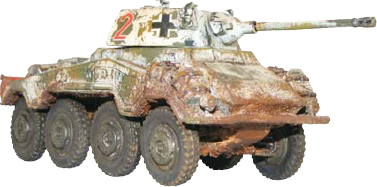
SdKfz 234/2 Puma armoured car
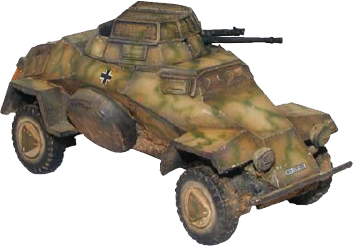
SdKfz 222 armoured car
The SdKfz 250 half-track was a shortened version of the Hanomag that was used both as a troop carrier and in a scouting or reconnaissance role. The versions covered here are the 250/9 armed with a 20mm cannon in an open-topped turret, and the 250/10 armed with a 37mm anti-tank gun.
| Cost: | 80pts (Inexperienced), 100pts (Regular), 120pts (Veteran) |
| Weapons: | One open turret-mounted light autocannon and co-axial MMG |
| Damage Value: | 7+ (armoured carrier) |
Options:
• May exchange turret and armament for forward facing light anti-tank gun (37mm Pak36 or 28mm sPzB 41) for +15pts
Special Rules:
• Open-topped
• Recce vehicle
German mechanised units are called Panzer Grenadiers and were amongst the elite of the whole army. The vehicle most often associated with these troops is the SdKfz 251 Hanomag armoured personal carrier. The Germans had a large range of half-tracked vehicles as transports and tows, and converted even soft-skin lorries to half-tracks to enable them to cope with conditions on the Russian front.
The Hanomag – named after its manufacturer Hannoversche Maschinenbau AG – was the ubiquitous German half-track used throughout World War II to transport mechanised infantry units – panzergrenadiers. The carrier version was adapted to various roles including the addition of close support weapons such as anti-tank guns, flame throwers, anti-aircraft guns, and even rockets. Engineering variants included bridge layers and telephone line layers, whilst further examples were built as radio cars, ambulances and command vehicles. The German designation for the carrier SdKfz 251 was short for special ordnance vehicle, and the standard infantry carrier version was the 251/1 which was able to carry up to 12 infantry in addition to its own crew. It was armed with a single pintle-mounted MG34 machine gun, and sometimes more. Platoon commanders’ vehicles carried a 37mm gun (251/10). Sometimes the anti-aircraft version (251/17) with 20mm autocannon was used as a substitute.
| Cost: | 67pts (Inexperienced), 84pts (Regular), 101pts (Veteran) |
| Weapons: | One forward facing pintle-mounted MMG covering the front arc |
| Damage Value: | 7+ (armoured carrier) |
| Transport: | Up to 12 men in basic version – up to 4 men with either light anti-tank gun or autocannon options added |
| Tow: | Light, medium or heavy anti-tank gun; light or medium howitzer |
Options:
• May add one additional rear facing pintle-mounted MMG covering rear arc for +10pts
• May exchange MMG for one forward facing light anti-tank gun (37mm Pak 36) for +40pts
• May exchange MMG for one pedestal-mounted light autocannon (Kwk 38) with 360-degree arc for +20pts
Special Rules:
• Open-topped
• Flak (pintle-mounted MMGs/light autocannons)
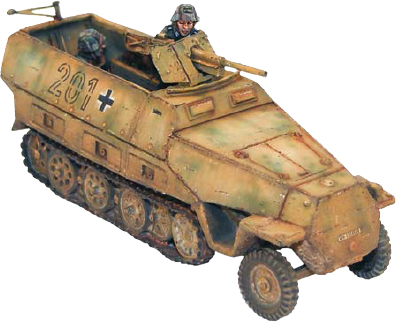
SdKfz 251/10 halftrack
The SdKfz 250 half-track was a shortened version of the Hanomag built primarily as a reconnaissance vehicle and as transport for forward observers, scouts and HQ units. Like the Hanomag it was built in a bewildering number of variants including cable layers, ammunition carriers, and radio cars. It carried six men in total including driver and co-driver – and we have allowed up to five men to be carried to enable the 250 to transport a half-sized squad assuming such troops double up as crew as needed.
| Cost: | 64pts (Inexperienced), 80pts (Regular), 96pts (Veteran) |
| Weapons: | One forward facing pintle-mounted MMG covering the front arc |
| Damage Value: | 7+ (armoured carrier) |
| Transport: | Up to 5 men |
| Tow: | Light howitzer; light or medium anti-tank guns |
Options:
• May add one additional rear facing pintle-mounted MMG covering rear arc for +10pts
Special Rules:
• Open-topped
• Flak (pintle-mounted MMGs)
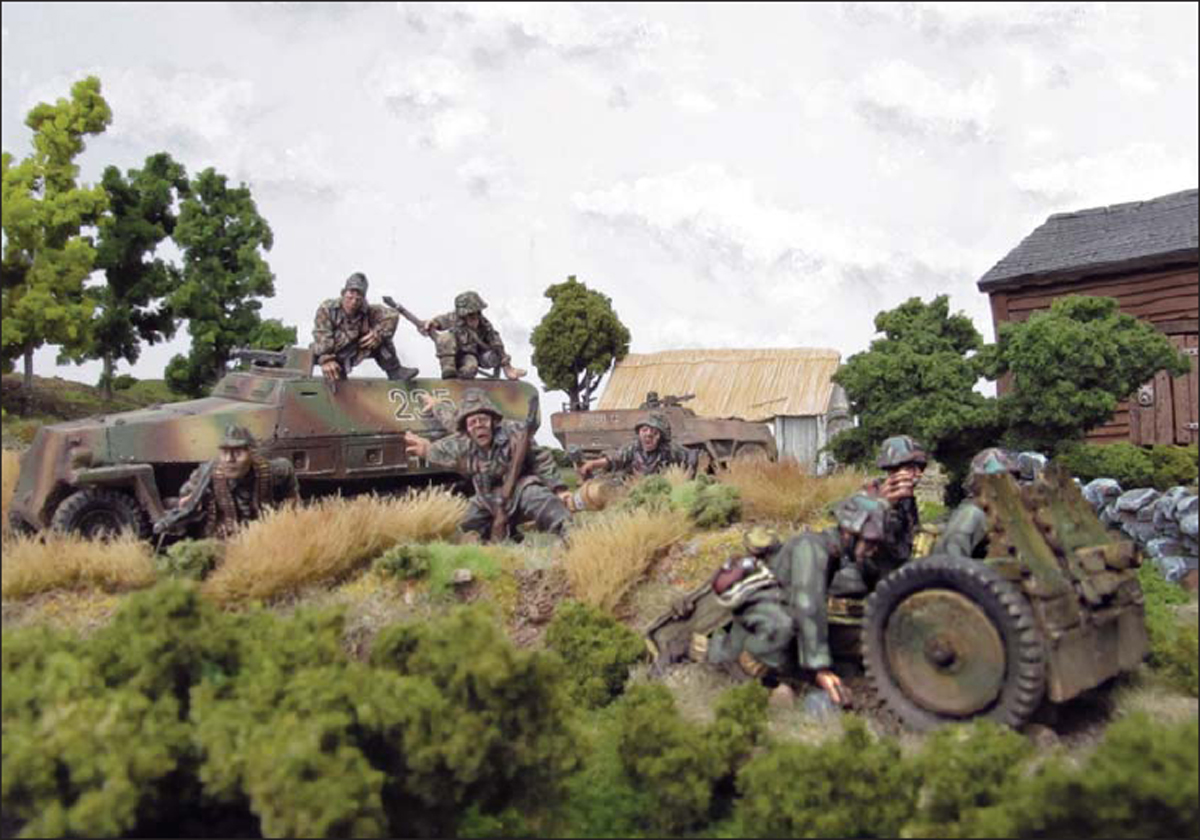
Panzergrenadiers debus from their halftrack
The SdKfz 7 was a half-track artillery tractor used to tow heavy guns such as the 88mm Flak and anti-tank guns and 150mm artillery piece. It was not generally used as a troop carrier as its ability to shift heavy loads made it more suitable as a tow, but it was capable of carrying up to 12 men in addition to its driver.
| Cost: | 35pts (Inexperienced), 44pts (Regular), 53pts (Veteran) |
| Weapons: | None |
| Damage Value: | 6+ (soft-skin carrier) |
| Transport: | Up to 12 men |
| Tow: | Any anti-tank gun or howitzer |
The Germans made use of a great many different types of truck, including those captured from their enemies. Perhaps the most well known is the Opel Blitz, although the six-wheeled Krupp-Protze was also widely used and is instantly recognisable. We shall not differentiate between one type of truck and another. Trucks were sometimes armed with a pintle-mounted machine gun, primarily for anti-aircraft defence, and we include the option here.
| Cost: | 31pts (Inexperienced), 39pts (Regular), 47pts (Veteran) |
| Weapons: | None |
| Damage Value: | 6+ (soft-skin) |
| Transport: | Up to 12 men |
| Tow: | Light howitzer; light or medium anti-tank gun |
Options:
• May have a pintle-mounted MMG with 360-degree arc of fire for +15pts
Special Rules:
• Flak (pintle-mounted MMG if included)
Maultier trucks – German for Mule – were half-track versions of trucks and could be based upon Opel Blitz, Mercedes or German Ford truck designs. They were built when it was found ordinary trucks couldn’t negotiate the thick mud encountered on the Eastern Front, and were simply converted from existing trucks and obsolete track components from the Panzer I. Trucks were sometimes armed with a pintle-mounted machine gun, primarily for anti-aircraft defence, and we include the option here.
| Cost: | 35pts (Inexperienced), 44pts (Regular), 53pts (Veteran) |
| Weapons: | None |
| Damage Value: | 6+ (soft-skin carrier) |
| Transport: | Up to 12 men |
| Tow: | Light howitzer; light or medium anti-tank gun |
Options:
• May have a forward facing pintle-mounted MMG covering the front arc for +10pts
Special Rules:
• Flak (pintle-mounted MMG if included)
The Kubelwagen was the military version of the Volkswagen and proved a reliable, rugged and much-liked little workhorse that saw action on every front. Although it lacked the four-wheel drive of Allied jeeps this was compensated for to some extent by its lighter construction, locking differential and good ground clearance. It could carry four men – three plus a driver – sufficient to carry a weapons team or HQ unit.
| Cost: | 17pts (Inexperienced), 21pts (Regular), 25pts (Veteran) |
| Weapons: | None |
| Damage Value: | 6+ (soft-skin) |
| Transport: | Up to 3 men |
Options:
• Can have a pintle-mounted MMG with a 360-degree arc for +15pts
The Schwimmwagen was adapted from the Kubelwagen to produce a four-wheel drive amphibious vehicle. It was widely used – and not just in an amphibious role –fulfilling a similar function to jeeps in the Allied armies.
| Cost: | 21pts (Inexperienced), 26pts (Regular), 31pts (Veteran) |
| Weapons: | None |
| Damage Value: | 6+ (soft-skin) |
| Transport: | Up to 3 men |
| Tow: | Light anti-tank gun |
Special Rules:
• Amphibious – can move deep water counting Slow and therefore limited to an advance move